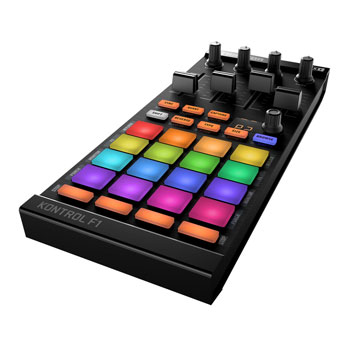

- #Controller editor native instruments manual
- #Controller editor native instruments software
- #Controller editor native instruments mac
The Auto button is the Auto Wr button on Mk2.The File/Save button is the All/Save button on Mk2.The Lock button is the Enter button on Mk2.4D-Encoder up/down: Use the 2 arrows below the encoder with Shift (STEP LEFT).4D-Encoder left/right: Use the 2 arrows below the encoder.The STEP RIGHT button (above the ERASE button) is the TAP TEMPO/METRO button.The STEP LEFT button (above the REC button) is used as both a replacement of the STOP and SHIFT button. The SHIFT button is not working in MIDI mode on the Mk2.The Mk3 and Maschine+ are identical (besides some slight label changes). Press Shift+CHANNEL (on the left / top) buttons to enter MIDI mode. This extension uses the MIDI mode of the device. Select the DrivenByMoss template in the controller editor.On the Maschine press Shift and select Knobs with the button over the 2nd display to move away from the template list.Select a template which does not overwrite the left/right button.If you are already stuck in the template list do the following to fix it: Therefore, you need to select the template from the controller editor. Important: Selecting the template is a bit tricky since when you activate a template from the Maschine which overwrites the left/right buttons you are stuck with the template list on the display. Load the respective template from the matching folder resources/Maschine Mk2, resources/Maschine Mk3, resources/Maschine+ or resources/Maschine Studio into the device by using Native Instruments Controller Editor.
#Controller editor native instruments mac
Since the extension requires the Native Instruments Host Integration service it only works on Windows and Mac (no Linux). Support for Native Instruments Maschine Mk2, Mk3, Maschine+ and Maschine Studio. Sometimes when you have a problem, only one person will fix it.you.Native Instruments Maschine Mk2 / Mk3 / Maschine+ / Studio But, of course, I had to make it way more flexible at the cost of being less immediately user-friendly. So, Librekontrol was born as a way to tie all of this together in a similar way: software-defined re-mapping of input events, including generating MIDI events, with concomitant LED activity. Those events are almost certainly software-defined in Windows via NI's controller editor. The hardware MIDI interfaces are unrelated to the MIDI events I was expecting to send over USB. Researching the problem more led me to read the kernel source for the Native Instruments caiaq module, where I found out that the devices are, indeed, serving dual roles as input devices that generate standard button and axis events and ALSA devices that feature hardware controls (LEDs), hardware MIDI in/out, and, potentially, audio in/out. Ps - In case you're not interested in doing the digital archaeology yourself, and to avoid necrobumping, this is a solution to a problem I reported three years ago.
#Controller editor native instruments manual
However, any controller that is recognized by the kernel as an input device is theoretically compatible.ĭownload v0.1, read the fine manual (including a tutorial), etc.

In its current state, several devices by Native Instruments (Maschine, Audio Kontrol 1, Kore, Kontrol S4/X1, etc.) are supported "out-of-the-box", or nearly so. This means that the sky is the limit with what you can do with Librekontrol: conveniently map the buttons on your device to keyboard shortcuts configured in a program, compose complex keyboard macros, or use your gamepad as a MIDI controller. Rather than simply offering a basic configuration system, Librekontrol is fully programmable through Guile, a dialect of the programming language Scheme.
#Controller editor native instruments software
Librekontrol can also create software MIDI ports through ALSA for any configured controller. As such, it also provides access to hardware features defined through ALSA (Advanced Linux Sound Architecture), typically LEDs on the device. In fact, music controllers are a primary focus of Librekontrol. You use Librekontrol to (re-)define the events that occur when you interact with a controller: keyboards, gamepads, music controllers, etc. Librekontrol is a programmable controller editor for GNU/Linux.


 0 kommentar(er)
0 kommentar(er)
